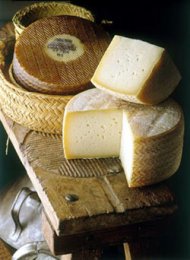
Spanish food - Manchego cheeseBuy Manchego cheese in our online store >>
Manchego cheese productionManchego is an aged cheese, from semi-cured to cured, made only with milk from manchega sheep breed, unpasteurised or pasteurised. It is produced through an enzimatic coagulation. The paste is pressed and uncooked. The base milk has to have a minimun of 6%
fat. The milk coagulates at 28 to 32 º C after adding animal
curd. Occasionally lactic ferments and calcium salts are also
added. This results in a compact curdle within 45 to 60 minutes.
The curdle must then be cut to obtain lumps of 5 to 10 mm. (1/5"
to 2/5"). The resulting lumpy paste is then slowly reheated
to about 40ºC (104ºF) The liquid is removed and the
dried paste put into molds where it is pressed for several hours.
The salting is external and is achieved either by rubbing with
dry salt, by immersing the cheese in highly salted water, or
by a combination of both methods. The percentage of the salt
in the weight of the cheese can not be higher than 2.3% after
two months of aging. The aging process must be done in fresh areas, with a humidity level of 75 to 85%, for at least 60 days. The rind is closed, clean well engraved, of a yellow to a brownish beige colour. The interior is firm and compact, closed, with a few small air pockets unevenly spread. The color is ivory to pale yellow. The taste is very characteristic, well developed, but not too strong, buttery and slightly piquant, with an sheep milk aftertaste. The shape is cylindrical, with flat top and bottom surfaces engraved with the tipical "flower" left by the wooden presses. The sides show a zigzag pattern produced by the mat-weed (esparto) of the moulds. Today, industrially produced cheeses have the same engraving, predesigned in the new industrial moulds. Manchego cheese links: Cheese reference
|
|
